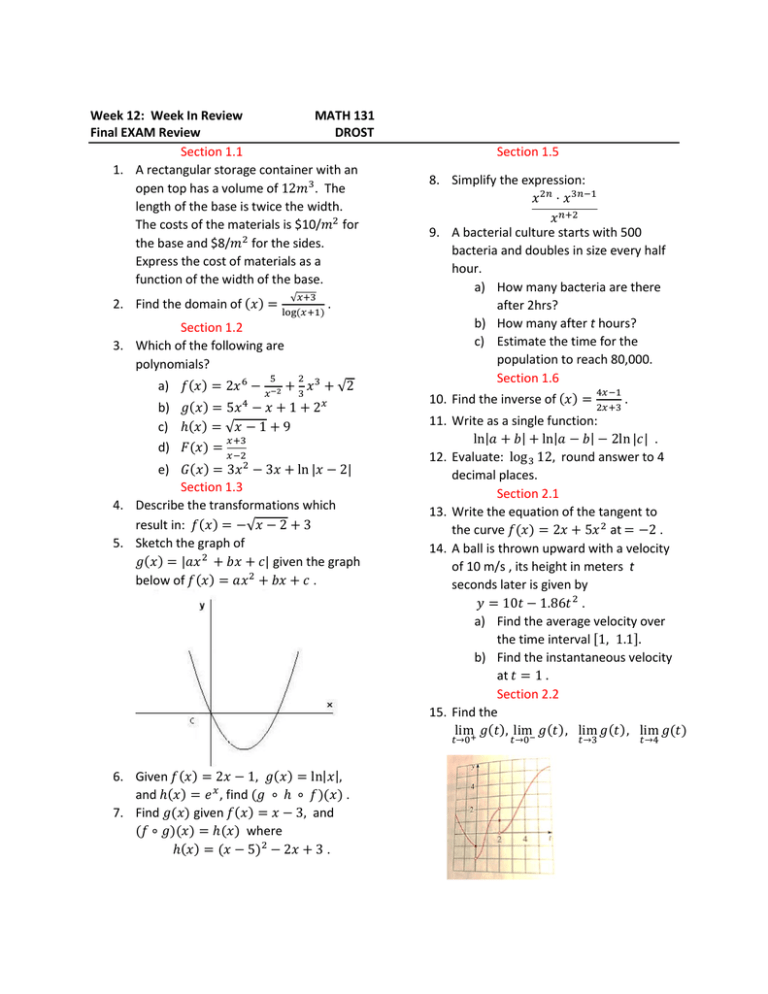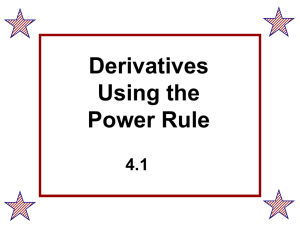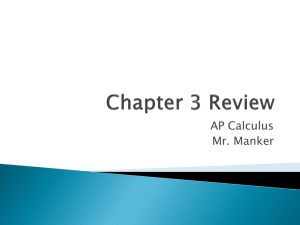Week 12: Week In Review ... Final EXAM Review ...
advertisement

Week 12: Week In Review MATH 131 Final EXAM Review DROST Section 1.1 1. A rectangular storage container with an open top has a volume of 12𝑚3. The length of the base is twice the width. The costs of the materials is $10/𝑚2 for the base and $8/𝑚2 for the sides. Express the cost of materials as a function of the width of the base. 2. Find the domain of (𝑥) = √𝑥+3 log(𝑥+1) . Section 1.2 3. Which of the following are polynomials? 5 2 a) 𝑓(𝑥) = 2𝑥 6 − 𝑥 −2 + 3 𝑥 3 + √2 4 b) 𝑔(𝑥) = 5𝑥 − 𝑥 + 1 + 2 c) ℎ(𝑥) = √𝑥 − 1 + 9 𝑥+3 d) 𝐹(𝑥) = 𝑥−2 𝑥 e) 𝐺(𝑥) = 3𝑥 2 − 3𝑥 + ln|𝑥 − 2| Section 1.3 4. Describe the transformations which result in: 𝑓(𝑥) = −√𝑥 − 2 + 3 5. Sketch the graph of 𝑔(𝑥) = |𝑎𝑥 2 + 𝑏𝑥 + 𝑐| given the graph below of 𝑓(𝑥) = 𝑎𝑥 2 + 𝑏𝑥 + 𝑐. Section 1.5 8. Simplify the expression: 𝑥 2𝑛 ⋅ 𝑥 3𝑛−1 𝑥 𝑛+2 9. A bacterial culture starts with 500 bacteria and doubles in size every half hour. a) How many bacteria are there after 2hrs? b) How many after t hours? c) Estimate the time for the population to reach 80,000. Section 1.6 10. Find the inverse of (𝑥) = . 11. Write as a single function: ln|𝑎 + 𝑏| + ln|𝑎 − 𝑏| − 2ln|𝑐| . 12. Evaluate: log 3 12, round answer to 4 decimal places. Section 2.1 13. Write the equation of the tangent to the curve 𝑓(𝑥) = 2𝑥 + 5𝑥 2 at = −2 . 14. A ball is thrown upward with a velocity of 10 m/s , its height in meters t seconds later is given by 𝑦 = 10𝑡 − 1.86𝑡 2 . a) Find the average velocity over the time interval [1, 1.1]. b) Find the instantaneous velocity at 𝑡 = 1. Section 2.2 15. Find the lim+ 𝑔(𝑡), lim− 𝑔(𝑡),lim 𝑔(𝑡),lim 𝑔(𝑡) 𝑡→0 6. Given 𝑓(𝑥) = 2𝑥 − 1, 𝑔(𝑥) = ln|𝑥|, and ℎ(𝑥) = 𝑒 𝑥 , find (𝑔 ∘ ℎ ∘ 𝑓)(𝑥) . 7. Find 𝑔(𝑥) given 𝑓(𝑥) = 𝑥 − 3, and (𝑓 ∘ 𝑔)(𝑥) = ℎ(𝑥) where ℎ(𝑥) = (𝑥 − 5)2 − 2𝑥 + 3 . 4𝑥−1 2𝑥+3 𝑡→0 𝑡→3 𝑡→4 𝑥 2 −2𝑥 Section 2.8 16. lim 𝑥 2 −𝑥−2 𝑥→2 Section 2.3 √𝑡 2 +9−3 𝑡2 𝑡→0 1 1 lim ( − 2 ) 𝑥 +𝑥 𝑥→0 𝑥 17. Find lim 18. Find Section 2.4 19. sin 𝑥 Evaluate lim 3+cos 𝑥 𝑥→𝜋 27. Given the graph of 𝑓 ′ (𝑥) , shown below, a) State the intervals where 𝑓(𝑥) is increasing. b) At what x-values does 𝑓(𝑥) have a rel. maximum? 20. State the values at which 𝑓(𝑥)is not continuous. Section 3.1 28. Find the derivative of 𝑓(𝑥) = 𝑏𝑥 3 + 𝑏 2 + 𝑏 2𝑥 29. Find the derivative of 𝑏 𝑐 𝑦 = 𝑎𝑒 2𝑣 + + 2 𝑣 𝑣 Section 3.2 Section 2.5 21. lim 𝑥→∞ 6𝑥 4 +5 (𝑥 2 −2)(2𝑥 2 −1) 22. lim − 𝑥→−5 𝑥−4 𝑥+5 Section 2.6 ′ (𝑎)𝑔𝑖𝑣𝑒𝑛𝑓(𝑥) 23. Find 𝑓 = √1 − 2𝑥 24. The displacement of a particle (in meters) moving in a straight line is given by 𝑠 = 𝑡 2 − 8𝑡 + 18, where t is measured in seconds. Find the average velocity over the interval [4,5]. Section 2.7 25. Find the derivative of 𝐹(𝑡) = 4𝑡 2𝑡−1 26. State the values where the function is not differentiable. 𝑥2 30. Given 𝑓(𝑥) = 𝑔(𝑥) , 𝑔(2) = −3, 𝑔′ (2) = 1 Find 𝑓′(2) 31. Find 𝑦′ given 𝑦 = 𝑥 3 ∙ tan 𝑥 Section 3.3 32. Find the derivative of 𝑦 = 𝑥𝑒 𝑥 ∙ csc 𝑥 𝑑 33. Show 𝑑𝑥 (csc 𝑥) = − csc 𝑥 ∙ cot 𝑥 Section 3.4 34. Find the derivative of 𝑦 = (2𝑥 + 3𝑥 4 )5 35. Differentiate 𝑦 = 𝑒 cos 𝑥 Section 3.7 36. Differentiate 𝑓(𝑥) = log 5(𝑥𝑒 −𝑥 ) 37. Let 𝑓(𝑥) = log 𝑎 (3𝑥 2 − 2) For what value of a is 𝑓 ′ (1) = 3? Section 3.8 6 38. Given 𝑠(𝑡) = 2𝑡 3 − 𝑡 + 5𝜋, s is measured in feet, and t in seconds. 23 39. 40. 41. 42. 43. 44. 45. 46. 47. 48. Find the acceleration at any time t , and at 3 seconds. If a ball is thrown vertically of 80𝑓𝑡/𝑠𝑒𝑐 then its height after t seconds is 𝑠 = 80𝑡 − 16𝑡 2 . a) What is the maximum height of the ball? b) What is the velocity of the ball when it is 96 ft above the ground on the way up? Section 4.2 Find the critical numbers of 𝑓(𝑥) = 3𝑥 4 + 4𝑥 3 − 6𝑥 2 Find the absolute extrema of 𝑦 = 𝑥 3 − 6𝑥 2 + 9𝑥 + 2 on the interval [−1, 4]. Section 4.3 𝑓(𝑥) = 2𝑥 3 + 3𝑥 2 − 36𝑥, a) Find where the function is ↘. b) Find where the function is ↗. c) Find where the function is ∪ . Find the critical numbers of 𝑓(𝑥) = 𝑥 4 (𝑥 − 1)3 . What does the 2nd Derivative Test tell you about each critical number? Section 4.6 Two numbers, x and y: what is the smallest possible value of the sum of their squares if 𝑥 + 2𝑦 = 30 ? If 1200𝑐𝑚2 of material is available to make a box with a square base and an open top, find the largest possible volume of the box. Section 4.8 Find the antiderivative of 𝑓(𝑥) = 𝑥(6 − 𝑥)2 Find the antiderivative of 𝑥 3 − 4𝑥 2 + 10 𝑔(𝑥) = √𝑥 Find the antiderivative of ℎ(𝑥) = 5𝑒 𝑥 + 4 cos 𝑥 49. Given 𝑓 ′′ (𝑥) = √𝑥 , 𝑓′(0) = 3, 𝑓(1) = 3 5, find 𝑓(𝑥). Section 5.1 50. Estimate the area under the graph of 𝑦 = |𝑥 − 2| from [−3, 6] by find 𝑅3 . 51. ∆𝑥 = Section 5.2 21 52. Approximate ∫1 𝑑𝑥 by finding 𝑀5 . 𝑥 53. Write as a single integral, a<b<c<d: 𝑐 𝑐 𝑎 ∫𝑎 𝑓(𝑥)𝑑𝑥 − ∫𝑑 𝑓(𝑥)𝑑𝑥 + ∫𝑏 𝑓(𝑥)𝑑𝑥 Section 5.3 9 1 𝑑𝑥 2𝑥 𝜋/4 ∫0 sec 𝜃 tan 𝜃𝑑𝜃 54. Evaluate: ∫1 55. Evaluate: Section 5.4 56. Find the derivative of 𝑡 𝑓(𝑡) = ∫ √3𝑥 − 8 𝑑𝑥 0 57. Find the derivative of 3𝑥 2 𝑔(𝑥) = ∫ 2𝑥 𝑡 −4 𝑑𝑡 𝑡2 + 1 Section 5.5 𝑥 58. ∫ 𝑒 √4 + 𝑒 𝑥 𝑑𝑥 59. ∫ (ln 𝑥)4 𝑥 𝑑𝑥 Section 6.1 60. Find the area bounded by 𝑓(𝑥) = 4𝑥 − 𝑥 2 and 𝑔(𝑥) = −3𝑥. 61. Find the area bounded by: 𝑥 = −𝑦 2 + 7 and 𝑥 = 𝑦 2 − 1. 62. Find the number c such that c bisects 1 the area under the curve 𝑦 = 𝑥 on the interval [2,10]. Section 6.5 63. Find the average value of 𝑓(𝑥) = (3 − 2𝑥)−1 ,[−1, 1] 64. Find the number(s) b, such that the average value of 𝑓(𝑥) = 2 + 6𝑥 − 3𝑥 2 on the interval [0, 𝑏] is 3. 65. Find the average value of 𝑦 = 6𝑥 2 − 4𝑥 − 1 on [−𝑎, 2𝑎]. Section 6.7 66. The demand function is 𝑝 = 20 − 0.05𝑥.Find the consumer surplus when the sales level is 300. 67. Use Poiseuille’s Law to calculate the rate of flow in a human artery where 𝜂 = 0.027, 𝑅 = .006𝑐𝑚, 𝑙 = 2𝑐𝑚 𝑃 = 4000𝑑𝑦𝑛𝑒𝑠/𝑐𝑚2 68. Find the area bounded by 1 𝑓(𝑥) = sin 𝑥 and 𝑔(𝑥) = 2 𝑥, 𝑦 = 𝑥 2 − 1. 69. Find A, B, and C such that 𝑦 = 𝐴𝑥 2 + 𝐵𝑥 + 𝐶 satisfies the differential equation 𝑦 ′′ − 𝑦 ′ + 2𝑦 = 𝑥 2 + 3𝑥 + 2. 70. Write in terms of 𝑢 = 𝑥 − 1, 𝑒 3 ∫ (𝑥 + 1)√𝑥 − 1 𝑑𝑥 2








